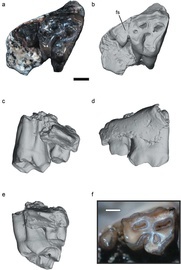Sengis (Elephant Shrews) from the Late Oligocene Nsungwe Formation of southwestern Tanzania.
[sciencythoughts.blogspot.com]
The Macroscelideans (also termed Sengis, or Elephant Shrews) are an enigmatic group of small insectivorous Mammals, known only from continental Africa. They are noted for their rapid movement, driven by powerful hind limbs, and elongate, flexible snouts, with 20 species known today, grouped into six genera. The history and relationships of this group were difficult to unravel. They have been linked to the Mixodectids (an extinct group of insectivorous Mammals related to the living Colougus of Southeast Asia), the Glires (Rodents and Lagomorphs), the Menotyphla (now rejected theoretical group of Mammals which included Treeshrews, Colougus, Primates, and some extinct groups), and the Condylarths (another rejected group, which comprised species now considered to be early Perissodactyls and Artiodactyls). To make matters more confusing, some fossils now attributed to the Macroscelidea were previously considered to be Hyraxes or Marsupials. More recently genetic studies of Mammal classification has led to Macroscelideans being placed within the Afrotherians, a group which also includes Aardvarks, Tenrecs, Hyraxes, Sirenians, and Elephants. Subsequent re-evaluations of the morphology of African Mammals has led to evidence supporting the Afrotherian hypothesis, which is now generally accepted by zoologists.


Enjoy being online again!
Welcome to the community of good people who base their values on evidence and appreciate civil discourse - the social network you will enjoy.Create your free account
Recent Visitors 12
NoSheep
OK, USA
tinkercreek
Portland Burb,
Notlost
Northeastern Oklahoma,
KateOahu
Oahu,
jasen
Glen Ellyn,
Photos 292 More
Posted by JoeBKite-like structures in the western Sahara Desert.
Posted by TriphidAn Aussie Indigenous Message Stick.
Posted by TriphidIndigenous Australian Aboriginal Rock art dated somewhere between 20 and 30 thousand years old.
Posted by TriphidIndigenous Australian Aboriginal Rock art dated somewhere between 20 and 30 thousand years old.
Posted by TriphidIndigenous Australian Aboriginal Rock art dated somewhere between 20 and 30 thousand years old.
Posted by TriphidIndigenous Australian Aboriginal Rock art dated somewhere between 20 and 30 thousand years old.
Posted by JoeBDortoka vremiri: A new species of Dortokid Turtle from the Late Cretaceous of the Hațeg Basin, Romania.
Posted by JoeBThe Cabeço da Amoreira burial: An Early Modern Era West African buried in a Mesolithic shell midden in Portugal.
Posted by JoeBMusivavis amabilis: A new species of Enantiornithine Bird from the Early Cretaceous Jehol Biota of northeastern China.
Posted by JoeBTorosaurus in Canada.
Posted by JoeBStone tools from the Borselan Rock Shelter, in the Binalud Mountains of northeastern Iran.
Posted by JoeBDating the Lantian Biota.
Posted by JoeBBashanosaurus primitivus: A new species of Stegosaur from the Middle Jurassic of Chongqing Municipality, China.
Posted by JoeBDetermining the time of year when the Chicxulub Impactor fell.
Posted by JoeBSão Tomé and Príncipe: Possibly the last country on Earth never to have been visited by a working archaeologist.
Posted by JoeBMambawakale ruhuhu: A new species of Pseudosuchian Archosaur from the Middle Triassic Manda Beds of Tanzania.






